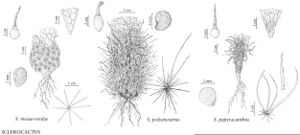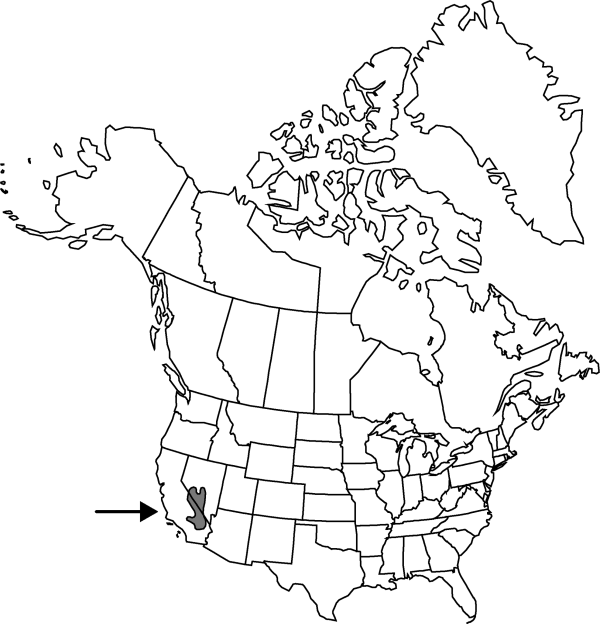FNA>Volume Importer |
FNA>Volume Importer |
| Line 26: |
Line 26: |
| | }}<!-- | | }}<!-- |
| | | | |
| − | --><span class="statement" id="st-d0_s0" data-properties="stem architecture;stem architecture;stem shape;stem shape;stem shape;stem atypical length;stem length;stem width"><b>Stems </b>unbranched or in clusters, cylindric or elongate cylindric, 10–40 (–45) × 5–9 cm;</span> <span class="statement" id="st-d0_s1" data-properties="rib count;rib development;tubercle prominence">ribs 13–17, well developed, tubercles not evident on ribs.</span> <span class="statement" id="st-d0_s2" data-properties="spine density"><b>Spines </b>dense, obscuring stems;</span> <span class="statement" id="st-d0_s3" data-properties="spine arrangement;spine atypical count;spine count;spine coloration;spine course;spine prominence or shape;spine some measurement;spine pubescence">radial spines 10–15 (–18) per areole, white, straight, flat, 20–50 mm, glabrous;</span> <span class="statement" id="st-d0_s4" data-properties="central spine count;central spine shape;areole count;other course;other shape;other shape;other shape">central spines 9–12 per areole, 5–8 hooked, others straight, terete to angled;</span> <span class="statement" id="st-d0_s5" data-properties="abaxial and lateral central spine count;abaxial and lateral central spine coloration;abaxial and lateral central spine coloration;abaxial and lateral central spine shape;abaxial and lateral central spine atypical length;abaxial and lateral central spine length;abaxial and lateral central spine width">abaxial and lateral central spines 6–8 per areole, red or reddish-brown (rarely yellow), some hooked, (30–) 56–100 × 0.7–1.2 mm;</span> <span class="statement" id="st-d0_s6" data-properties="adaxial central spine count;adaxial central spine coloration;adaxial central spine course;adaxial central spine architecture;adaxial central spine prominence or shape;adaxial central spine atypical length;adaxial central spine length;adaxial central spine width">adaxial central spines usually 3 per areole, white, usually curved or twisted, flat, usually 37–86 (–130) × 1.7–3.4 mm.</span> <span class="statement" id="st-d0_s7" data-properties="flower shape;flower length;flower width"><b>Flowers </b>with spicy, pungent odor, funnelform, 5–10 × 5–9 cm;</span> <span class="statement" id="st-d0_s8" data-properties="outer tepal coloration;outer tepal coloration;outer tepal shape;outer tepal length;outer tepal width;midstripe coloration">outer tepals with greenish purple midstripes and rose-purple or magenta margins, cuneate-spatulate, usually 15–30 × 6–9 mm;</span> <span class="statement" id="st-d0_s9" data-properties="inner tepal coloration;inner tepal coloration;inner tepal coloration;largest tepal shape;largest tepal length;largest tepal width">inner tepals rose-purple to magenta (rarely white), largest tepals ovatelanceolate, 24–45 × 9–12 mm;</span> <span class="statement" id="st-d0_s10" data-properties="filament coloration">filaments greenish yellow;</span> <span class="statement" id="st-d0_s11" data-properties="anther coloration">anthers cream;</span> <span class="statement" id="st-d0_s12" data-properties="style architecture;style relief">style grooved, not papillate.</span> <span class="statement" id="st-d0_s13" data-properties="fruit dehiscence;fruit coloration;fruit coloration;fruit coloration;fruit coloration;fruit coloration;fruit shape;fruit length;fruit width;fruit condition or texture"><b>Fruits </b>irregularly dehiscent at base, green, tan, or red, barrel-shaped, 22–50 × 12–25 mm, dry at maturity;</span> <span class="statement" id="st-d0_s14" data-properties="scale count;scale coloration;scale shape">scales few, white fringed.</span> <span class="statement" id="st-d0_s15" data-properties="seed coloration;seed length;seed width;seed reflectance"><b>Seeds </b>black, 2.7–3.7 × 2–2.5 mm, shiny;</span> <span class="statement" id="st-d0_s16" data-properties="papilla width;papilla shape">testa with fine, rounded papillae.</span><!-- | + | --><span class="statement" id="st-undefined" data-properties=""><b>Stems </b>unbranched or in clusters, cylindric or elongate cylindric, 10–40(–45) × 5–9 cm; ribs 13–17, well developed, tubercles not evident on ribs. <b>Spines</b> dense, obscuring stems; radial spines 10–15(–18) per areole, white, straight, flat, 20–50 mm, glabrous; central spines 9–12 per areole, 5–8 hooked, others straight, terete to angled; abaxial and lateral central spines 6–8 per areole, red or reddish brown (rarely yellow), some hooked, (30–)56–100 × 0.7–1.2 mm; adaxial central spines usually 3 per areole, white, usually curved or twisted, flat, usually 37–86(–130) × 1.7–3.4 mm. <b>Flowers</b> with spicy, pungent odor, funnelform, 5–10 × 5–9 cm; outer tepals with greenish purple midstripes and rose-purple or magenta margins, cuneate-spatulate, usually 15–30 × 6–9 mm; inner tepals rose-purple to magenta (rarely white), largest tepals ovate-lanceolate, 24–45 × 9–12 mm; filaments greenish yellow; anthers cream; style grooved, not papillate. <b>Fruits</b> irregularly dehiscent at base, green, tan, or red, barrel-shaped, 22–50 × 12–25 mm, dry at maturity; scales few, white fringed. <b>Seeds</b> black, 2.7–3.7 × 2–2.5 mm, shiny; testa with fine, rounded papillae.</span><!-- |
| | | | |
| | -->{{Treatment/Body | | -->{{Treatment/Body |
| | + | |phenology=Flowering Apr–Jun. |
| | |habitat=Rocky alluvial, often alkaline soils, Mojave desert scrub | | |habitat=Rocky alluvial, often alkaline soils, Mojave desert scrub |
| | |elevation=500-2500 m | | |elevation=500-2500 m |
| Line 48: |
Line 49: |
| | |basionyms=Echinocactus polyancistrus | | |basionyms=Echinocactus polyancistrus |
| | |family=Cactaceae | | |family=Cactaceae |
| | + | |phenology=Flowering Apr–Jun. |
| | |habitat=Rocky alluvial, often alkaline soils, Mojave desert scrub | | |habitat=Rocky alluvial, often alkaline soils, Mojave desert scrub |
| | |elevation=500-2500 m | | |elevation=500-2500 m |
| Line 55: |
Line 57: |
| | |publication year=1922 | | |publication year=1922 |
| | |special status= | | |special status= |
| − | |source xml=https://jpend@bitbucket.org/aafc-mbb/fna-fine-grained-xml.git/src/287ef3db526bd807d435a3c7423ef2df1e951227/V4/V4_384.xml | + | |source xml=https://jpend@bitbucket.org/aafc-mbb/fna-data-curation.git/src/9216fc802291cd3df363fd52122300479582ede7/coarse_grained_fna_xml/V4/V4_384.xml |
| | |subfamily=Cactaceae subfam. Cactoideae | | |subfamily=Cactaceae subfam. Cactoideae |
| | |genus=Sclerocactus | | |genus=Sclerocactus |
| | |species=Sclerocactus polyancistrus | | |species=Sclerocactus polyancistrus |
| − | |abaxial and lateral central spine atypical length=30mm;56mm
| |
| − | |abaxial and lateral central spine coloration=reddish-brown;red
| |
| − | |abaxial and lateral central spine count=6;8
| |
| − | |abaxial and lateral central spine length=56mm;100mm
| |
| − | |abaxial and lateral central spine shape=hooked
| |
| − | |abaxial and lateral central spine width=0.7mm;1.2mm
| |
| − | |adaxial central spine architecture=twisted
| |
| − | |adaxial central spine atypical length=86mm;130mm
| |
| − | |adaxial central spine coloration=white
| |
| − | |adaxial central spine count=3
| |
| − | |adaxial central spine course=curved
| |
| − | |adaxial central spine length=37mm;86mm
| |
| − | |adaxial central spine prominence or shape=flat
| |
| − | |adaxial central spine width=1.7mm;3.4mm
| |
| − | |anther coloration=cream
| |
| − | |areole count=5;8
| |
| − | |central spine count=9;12
| |
| − | |central spine shape=hooked
| |
| − | |filament coloration=greenish yellow
| |
| − | |flower length=5cm;10cm
| |
| − | |flower shape=funnelform
| |
| − | |flower width=5cm;9cm
| |
| − | |fruit coloration=red;tan;red;tan;green
| |
| − | |fruit condition or texture=dry
| |
| − | |fruit dehiscence=dehiscent
| |
| − | |fruit length=22mm;50mm
| |
| − | |fruit shape=barrel-shaped
| |
| − | |fruit width=12mm;25mm
| |
| − | |inner tepal coloration=rose-purple;magenta
| |
| − | |largest tepal length=24mm;45mm
| |
| − | |largest tepal shape=ovatelanceolate
| |
| − | |largest tepal width=9mm;12mm
| |
| − | |midstripe coloration=greenish purple
| |
| − | |other course=straight
| |
| − | |other shape=terete;angled
| |
| − | |outer tepal coloration=magenta;rose-purple
| |
| − | |outer tepal length=15mm;30mm
| |
| − | |outer tepal shape=cuneate-spatulate
| |
| − | |outer tepal width=6mm;9mm
| |
| − | |papilla shape=rounded
| |
| − | |papilla width=fine
| |
| − | |rib count=13;17
| |
| − | |rib development=developed
| |
| − | |scale coloration=white
| |
| − | |scale count=few
| |
| − | |scale shape=fringed
| |
| − | |seed coloration=black
| |
| − | |seed length=2.7mm;3.7mm
| |
| − | |seed reflectance=shiny
| |
| − | |seed width=2mm;2.5mm
| |
| − | |spine arrangement=radial
| |
| − | |spine atypical count=15;18
| |
| − | |spine coloration=white
| |
| − | |spine count=10;15
| |
| − | |spine course=straight
| |
| − | |spine density=dense
| |
| − | |spine prominence or shape=flat
| |
| − | |spine pubescence=glabrous
| |
| − | |spine some measurement=20mm;50mm
| |
| − | |stem architecture=in clusters;unbranched
| |
| − | |stem atypical length=40cm;45cm
| |
| − | |stem length=10cm;40cm
| |
| − | |stem shape=cylindric;elongate;cylindric
| |
| − | |stem width=5cm;9cm
| |
| − | |style architecture=grooved
| |
| − | |style relief=not papillate
| |
| − | |tubercle prominence=not evident
| |
| | }}<!-- | | }}<!-- |
| | | | |
| | -->[[Category:Treatment]][[Category:Sclerocactus]] | | -->[[Category:Treatment]][[Category:Sclerocactus]] |
Stems unbranched or in clusters, cylindric or elongate cylindric, 10–40(–45) × 5–9 cm; ribs 13–17, well developed, tubercles not evident on ribs. Spines dense, obscuring stems; radial spines 10–15(–18) per areole, white, straight, flat, 20–50 mm, glabrous; central spines 9–12 per areole, 5–8 hooked, others straight, terete to angled; abaxial and lateral central spines 6–8 per areole, red or reddish brown (rarely yellow), some hooked, (30–)56–100 × 0.7–1.2 mm; adaxial central spines usually 3 per areole, white, usually curved or twisted, flat, usually 37–86(–130) × 1.7–3.4 mm. Flowers with spicy, pungent odor, funnelform, 5–10 × 5–9 cm; outer tepals with greenish purple midstripes and rose-purple or magenta margins, cuneate-spatulate, usually 15–30 × 6–9 mm; inner tepals rose-purple to magenta (rarely white), largest tepals ovate-lanceolate, 24–45 × 9–12 mm; filaments greenish yellow; anthers cream; style grooved, not papillate. Fruits irregularly dehiscent at base, green, tan, or red, barrel-shaped, 22–50 × 12–25 mm, dry at maturity; scales few, white fringed. Seeds black, 2.7–3.7 × 2–2.5 mm, shiny; testa with fine, rounded papillae.
Phenology: Flowering Apr–Jun.
Habitat: Rocky alluvial, often alkaline soils, Mojave desert scrub
Elevation: 500-2500 m
Distribution
Calif., Nev.
Discussion
Sclerocactus polyancistrus is the only member of the genus that truly lacks papillae on the style, and its style possesses grooves, somewhat reminiscent of Ferocactus. It is easily recognized by its massive stem size (relative to other species of Sclerocactus), large flowers, and numerous hooked central spines (five to nine).
Selected References
None.

